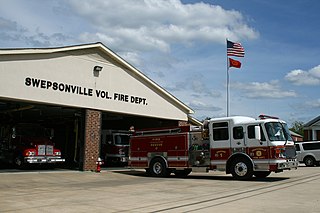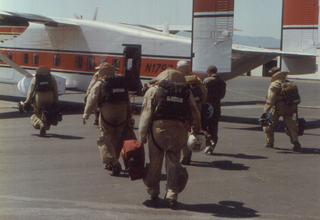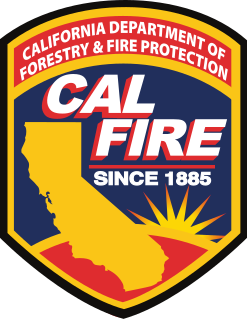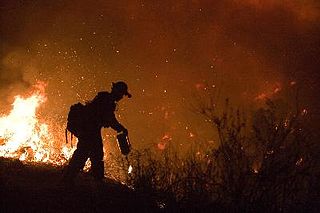
A volunteer fire department (VFD) is a fire department consisting of volunteers who perform fire suppression and other related emergency services for a local jurisdiction. Volunteer and retained firefighters are expected to be on call to respond to emergency calls for long periods of time, and are summoned to the fire station when their services are needed. They are also expected to attend other non-emergency duties as well.

Smokejumpers are specially trained wildland firefighters who provide an initial attack response on remote wildland fires. They are inserted at the site of the fire by parachute.

Aerial firefighting is the use of aircraft and other aerial resources to combat wildfires. The types of aircraft used include fixed-wing aircraft and helicopters. Smokejumpers and rappellers are also classified as aerial firefighters, delivered to the fire by parachute from a variety of fixed-wing aircraft, or rappelling from helicopters. Chemicals used to fight fires may include water, water enhancers such as foams and gels, and specially formulated fire retardants such as Phos-Chek.
Firefighting jargon includes a diverse lexicon of both common and idiosyncratic terms. One problem that exists in trying to create a list such as this is that much of the terminology used by a particular department is specifically defined in their particular standing operating procedures, such that two departments may have completely different terms for the same thing. For example, depending on whom one asks, a safety team may be referred to as a standby, a RIT or RIG or RIC, or a FAST. Furthermore, a department may change a definition within its SOP, such that one year it may be RIT, and the next RIG or RIC.
This glossary of wildfire terms is a list of definitions of terms and concepts relevant to wildfires and wildland firefighting. Except where noted, terms have largely been sourced from a 1998 Fireline Handbook transcribed for a Conflict 21 counter-terrorism studies website by the Air National Guard.
A fire retardant is a substance that is used to slow down or stop the spread of fire or reduce its intensity. This is commonly accomplished by chemical reactions that reduce the flammability of fuels or delay their combustion. Fire retardants may also cool the fuel through physical action or endothermic chemical reactions. Fire retardants are available as powder, to be mixed with water, as fire-fighting foams and fire-retardant gels. Fire retardants are also available as coatings or sprays to be applied to an object.

The California Department of Forestry and Fire Protection is a fire department of the California Natural Resources Agency in California, United States. It is responsible for fire protection in various areas under state responsibility totaling 31 million acres, as well as the administration of the state's private and public forests. In addition, the department provides varied emergency services in 36 of the state's 58 counties via contracts with local governments. The department's director is Thom Porter, who was appointed by Governor of California Gavin Newsom.

In the United States, a hotshot crew, formally known as an interagency hotshot crew, is a handcrew of 20-22 wildland firefighters that respond to large, high-priority fires across the country and are assigned to work the most challenging parts of the fire. They have specific qualifications to provide leadership for initial-attack and extended-attack on wildland fires, and are trained/equipped to work in remote areas for extended periods of time with little logistical support. Hotshot crews are the most highly trained, skilled, and experienced type of handcrews. Hotshot crews are organized by agencies such as the United States Forest Service, National Park Service, Bureau of Indian Affairs, Bureau of Land Management, and state and county agencies. The National Interagency Fire Center in coordinates hotshot crews on the national level.

Wildfire suppression is a range of firefighting tactics used to suppress wildfires. Firefighting efforts in wild land areas require different techniques, equipment, and training from the more familiar structure fire fighting found in populated areas. Working in conjunction with specially designed aerial firefighting aircraft, these wildfire-trained crews suppress flames, construct fire lines, and extinguish flames and areas of heat to protect resources and natural wilderness. Wildfire suppression also addresses the issues of the wildland-urban interface, where populated areas border with wild land areas.

Incident management team (IMT) is a term used in the United States of America to refer to a group of trained personnel that responds to an emergency. Although the incident management team concept was originally developed for wildfire response, it has been expended into what is now known as "All-Hazards Incident Management Team”. An AHIMT can respond to a wide range of emergencies, including fires, floods, earthquakes, hurricanes, tornadoes, tsunami, riots, spilling of hazardous materials, and other natural or human-caused incidents.

The National Interagency Fire Center (NIFC) in Boise, Idaho is the physical facility which is the home to the National Interagency Coordination Center (NICC), and the National Multi-Agency Coordination group.

The National Wildfire Coordinating Group (NWCG) was formed in the United States as a result of the aftermath of a major wildfire season in 1970.
In wildland fire suppression in the United States, S-130/S-190 refers to the basic wildland fire training course required of all firefighters before they can work on the firelines.

Handcrews are diverse teams of career and temporary wildland firefighters. The crews typically consist of 18 - 20 men and women but can also contain 4 to 6 and 8 to 10. These crews have the responsibilities of constructing firelines – strips of land cleared of flammable materials and dug down to mineral soil. These lines are generally constructed around wildfires to control them. Another type of line handcrews create is saw line. This is line where all trees limbs are removed up to shoulder height and all small trees and brush is cut down. All the limbs and trees are then carried outside the line and scattered. These are also called ladder fuels that allow the fire to climb up into the canopies which makes controlling a fire much more difficult. Sawyers do the cutting and swampers do the moving of the debris. Depending on the size of the crew there can be between 1 and 5 swampers per sawyer. Other jobs include burn outs, gridding for spot fires, and mop up after the fire is controlled.

The Modular Airborne FireFighting System (MAFFS) is a self-contained unit used for aerial firefighting that can be loaded onto a Lockheed C-130 Hercules, a military cargo transport, which then allows the aircraft to be used as an air tanker against wildfires. This allows the U.S. Forest Service (USFS) to use military aircraft from the Air National Guard and Air Force Reserve to serve as an emergency backup resource to the civilian air tanker fleet.
Helitack crews are teams of wildland firefighters who are transported by helicopter to wildfires. Helicopters provide rapid transport, enabling helitack crews to quickly respond and assess a wildfire situation. Helitack crews may land near a wildfire or, if equipped and trained, rappel from a hovering helicopter. Once on the ground, crews build firelines using hand tools, chainsaws, and other firefighting tools. They often remain overnight in remote locations. After they have completed their assignment, crew members may pack up to 120 pounds of equipment over difficult terrain to reach a pick-up point. Rappellers often prepare helispots that provide better access to a fire. Helicopter crew members may also perform other duties such as tree falling, firing operations, and managing helibases.

A fire use module (FUM) is a 7–10 person team of firefighting personnel dedicated to planning, monitoring and starting fires. They may be deployed anywhere in the United States for resource benefits, prescribed fire and hazard fuel reduction projects.
Wildfire suppression equipment and personnel is part of the science of fire fighting focusing on the use of specialized equipment, training and tactics to effectively control, surround and eventually extinguish a natural cover fire. There are several specially designed tools that through their function and user training, perform specialized tasks that are specific to natural cover firefighting. This is used together in conjunction with the general understanding of the behavior of fire to form a viable plan of attack.
The Wildland Fire Lessons Learned Center (LLC), established in 2002, is at the National Advanced Fire and Resource Institute (NAFRI) in Tucson, Arizona. The LLC is primarily a Web-based educational and knowledge resource center that serves the entire wildland fire community. The LLC provides tools and tactics to the wildland fire community to ensure safety and effectiveness in all field operations. The center is supported by the National Wildfire Coordinating Group (NWCG), which includes multiple federal, state, and local land management and firefighting agencies.











